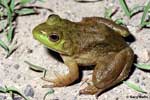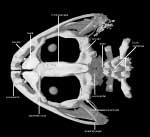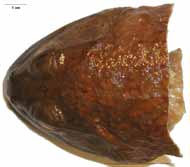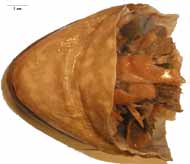|
The American bullfrog is native to central and eastern North America (Austin et al., 2004). However, the bullfrog has been introduced into other regions in the Americas including western Canada (Govindarajulu et al., 2006), Jamaica (Mahon and Aiken, 1977), and Venezuela (Hanselmann et al., 2004). The species is mostly aquatic and needs a permanent body of water in order to forage and reproduce (Austin et al., 2004). Bullfrogs are carnivorous and typically feed on large prey. Their diet consists of small mammals, birds, turtles, snakes, and other small anurans (Duellman and Trueb, 1986). |
Rana catesbeiana is a member of Ranidae, a diverse group of frogs. Ranids are cosmopolitan except for the southern portion of South America, the West Indies, most of Australia, and most oceanic islands (Duellman and Trueb, 1986; Pough et al., 2004). Size is variable among ranids, with the smallest frogs averaging less than 50 mm in length and the largest frog averaging 300 mm in length (Duellman and Trueb, 1986).
Frogs and toads are anurans, comprising one of the three groups of amphibians. Anurans are the largest amphibian group with about 344 extant genera and 4800 extant species. Several new species of anurans are discovered every year, mostly in the tropics. Anurans are found worldwide, although they are not well adapted for cold climates (Pough et al., 2004).
The cranial anatomy of anurans distinguishes them from other amphibians. Most notably, anurans have a reduced number of cranial elements. The frontal and parietal bones are fused into one element, the frontoparietal. Additionally, teeth are absent in the dentary in all but one species (Pough et al., 2004).
Anurans can be divided into different locomotor categories based on the length of the forelimb relative to that of the hindlimb. Typically, frogs with longer forelimbs are adapted for walking, running, and hopping, while frogs with longer hindlimbs are adapted for jumping and swimming. Anurans have several adaptations for their leaping behavior. The ankle bones (tibiale and fibulare) are elongated and fused at the proximal and distal ends. In the forelimb, the radius and ulna are fused into one element (radioulna), as are the tibia and fibula (tibiafibula) in the hindlimb. In addition to specialized limb morphology, all anurans lack a tail and the caudal vertebrae are fused into a single element called the urostyle (Pough et al., 2004).
Three reproductive strategies are found among anurans. The first and most common is aquatic larvae. Tadpoles hatch from eggs that are deposited in water and later develop into adult frogs through metamorphosis. This strategy is employed by Rana catesbeiana. Other frogs lay eggs that once hatched, directly develop into frogs without a tadpole phase. Finally, some species use viviparity or birth of small frogs, also without a tadpole phase (Pough et al., 2004).
Bullfrog larvae require up to two years before metamorphosis (Pough et al., 2004). Sexual maturity is usually reached about a year after metamorphosis (Duellman and Trueb, 1986). Although females only produce one clutch during their first breeding season, older females can produce two clutches within a breeding season. Clutches are deposited in still, shallow water on a film with the eggs on the water’s surface (Duellman and Trueb, 1986).
Bullfrogs are seasonal breeders, with mating occurring for two to three months in the summer. Males are territorial and defend their territories with aggressive calling and wrestling other males. Females often visit multiple territories before choosing a mate. A female’s mate choice is dependent mostly upon the quality of oviposition sites within a male’s territory. Good oviposition sites will ensure faster development and have less threats of predation (Pough et al., 2004).
Additional Information on the Skull
Click on the thumbnails below for labeled images of the skull in standard anatomical views.

About the Species
This female specimen was collected from Gonzales, Texas. It was made available to The University of Texas High-Resolution X-ray CT Facility for scanning by Dr. David Cannatella of The University of Texas and the Amphibian Tree of Life project (EF-0334952). Funding for scanning and image processing was provided by Dr. Cannatella's grant, and funding for additional image processing was provided by a National Science Foundation Digital Libraries Initiative grant to Dr. Timothy Rowe of The University of Texas at Austin.

About this Specimen
This specimen was scanned by Matthew Colbert on 8 November 2004 along the coronal axis for a total of 480 1024x1024 pixel slices. Each slice is 0.1443 mm thick, with an interslice spacing of 0.1443 mm and a field of reconstruction of 68 mm.

About the
Scan
Literature
Austin, J. D., S. C. Lougheed, and P. T. Boag. 2004. Controlling for the effects of history and nonequilibrium conditions in gene flow estimates in Northern Bullfrog (Rana catesbeiana) populations. Genetics 168:1491-1506.
Duellman, W. E., and L. Trueb. 1986. Biology of Amphibians. Johns Hopkins, Baltimore, 670 pp.
Ford, L. S. and D. C. Cannatella. 1993. The major clades of frogs. Herpetological Monographs 7:94-117.
Govindarajulu, P., W. S. Price, and B. R. Anholt. 2006. Introduced bullfrogs (Rana catesbeiana) in Western Canada: Has their ecology diverged? Journal of Herpetology 40:249-260.
Hanselmann R., A. Rodriguez, M. Lampo, L. Fajardo-Ramos, A. A. Aguirre, A. M. Kilpatrick, J. P. Rodriquez, and P. Daszak. 2004. Presence of an emerging pathogen of amphibians in introduced bullfrogs Rana catesbeiana in Venezuela. Biological Conservation 120:115-119.
Mahon, R., and K. Aiken. 1977. Establishment of North-American Bullfrogs, Rana catesbeiana (Amphibia, Anura, Ranidae) in Jamaica. Journal of Herpetology 11:197-199.
Pough, F. H., R. M. Andrews, J. E. Cadle, M. L. Crump, A. H. Savitzky, and K. D. Wells. 2004. Herpetology. Pearson Education, Inc., Upper Saddle River, NJ. 726.
Links
Information and images of Rana catesbeiana on the Animal Diversity Web (University of Michigan Museum of Zoology)
Information about R. catesbeiana on AmphibiaWeb (University of California, Berkeley)
'Ranidae' on the the Tree of Life web project

Literature
& Links
Front page image.
| 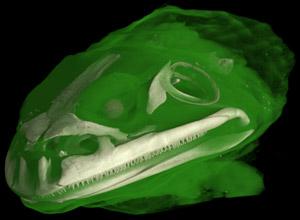 |

Additional
Imagery
|








